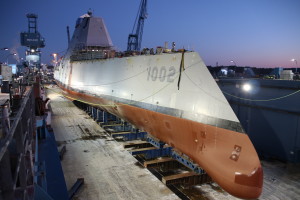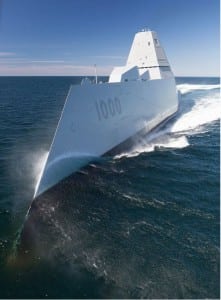The Navy awarded HII’s Ingalls Shipbuilding [HII] a $42 million contract modification to start combat systems activation work on the future Zumwalt-class destroyer USS
Lyndon B. Johnson (DDG-1002).
This modification definitizes a previous award, with the announcement disclosing HII will cover “temporary dock services and maintenance to the ship (including, but not limited to, preventative and corrective maintenance), as required, as well as management, labor, material, facilities, emergent work support and maintenance as required, to accomplish the combat systems availability (CSA) for DDG-1002.”

The work will occur at HII’s shipyard in Pascagoula, Miss., and is expected to be finished by October 2023.
In a statement, HII elaborated that under this CSA work, it will complete the installation, activation and testing of the combat systems” to ensure a fully functional system is ready to operate in the Navy fleet, as part of the Navy’s phased delivery approach.”
The company said this $42 million award specifically allows HII to start program management, labor, materials and facilities to conduct the industrial efforts and fleet industrial efforts to support DDG-1002’s combat system.
“HII is excited to support our Navy colleagues in bringing this new capability to the fleet. As a dedicated partner in the construction and system activation of Navy destroyers, Ingalls is eager to leverage our shipbuilders’ expertise and modernized facilities in supporting the Navy’s future generation systems and platforms,” Ingalls Shipbuilding President Kari Wilkinson said in a statement.
Previously, the other two Zumwalt-class ships underwent their own combat system activations at Naval Station San Diego with Raytheon Technologies [RTX] as prime contractor. The CSA work is the second part of ship delivery following an initial hull, mechanical and engineering delivery from shipbuilder General Dynamics’s Bath Iron Works in Maine.
The Navy accepted GD’s portion of the work as completed in November 2021 after delays related to deficiencies and modifications for a safe workplace during the COVID-19 pandemic. The ship departed for Pascagoula in January. The Johnson is expected to be delivered as soon as April 2024.
According to a 2022 annual Government Accountability Office (GAO) report assessing major weapon systems released in June, further delays for DDG-1002 are possible given a different contractor, HII, is installing the weapon systems than the one used on the other two hulls.
This difference “could result in some loss of efficiencies gained by the contractor on the other two ships,” the report said.
The previous 2021 GAO report explained why the Navy changed its delivery plan for DDG-1002.
“According to the program manager, instead of taking custody of the ship from the builder’s yard and completing the combat system at Naval Base San Diego, the Navy is now planning to contract with a private shipyard to install the combat system and will not take delivery or commission DDG-1002 until it is fully complete,” the June 2021 report said.

The program manager admitted while the change may cause additional schedule delays, it will “free up valuable pier space in Naval Base San Diego and enable the Navy to avoid moving the crew onboard DDG-1002 until it is ready to operate.”
The report said the program manager noted the change was responding to lessons learned from the earlier sister ships, DDG-1000 and DDG-1001, “that completing combat system activation and final construction is complicated by onboard crew, in part, because access to spaces is more constrained.”
Last year, the Navy’s FY ‘22 budget request documents said the service was planning to replace the unused BAE Systems Advanced Gun System (AGS) on the Zumwalt-class destroyers with Conventional Prompt Strike (CPS) hypersonic weapon launch tubes and magazines. The announcement did not say if the work at Pascagoula will include replacing the AGS with CPS (Defense Daily, June 8, 2021).